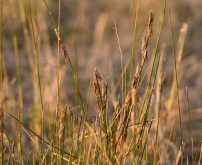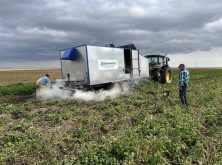Breanne Tidemann has led several research projects looking at whether harvest weed seed control can effectively control weeds. She’s found that combining harvest weed seed control with early-maturing crops may limit wild oat populations, and may lengthen the effectiveness of available herbicides.
Harvest weed seed control, developed in Australia, uses equipment such as the Harrington Seed Destructor or Seed Terminator, or methods such as chaff lining, to reduce weed seeds in the field. Wild oats, however, generally shed seeds too early for such methods to be effective in Western Canada.
Tidemann’s project examined whether producers could target wild oats with these methods by growing early-maturing crops. The early-maturing rotation comprised field peas followed by winter wheat. The “normal” rotation was spring wheat followed by canola, and the late was faba beans followed by flax. Researchers found early-maturing crops allowed researchers to collect more wild oat seeds in the chaff than “normal” or late-maturing crop, making those rotations better candidates for harvest weed seed control. Researchers also found some benefit to swathing over straight cutting, but results weren’t statistically significant.
Read Also

Cancer agency reclassifies another herbicide ‘probably carcinogenic’
The WHO’s cancer research agency has now put atrazine, a herbicide well known to corn growers, in the same potential-hazard category where the agency put glyphosate.
Read the full report online.















